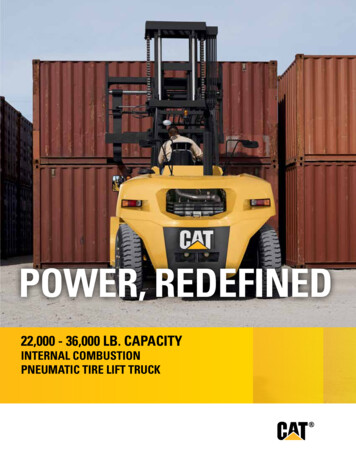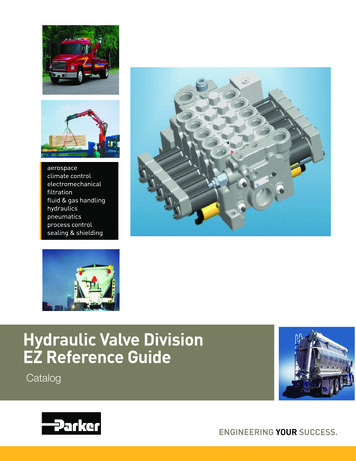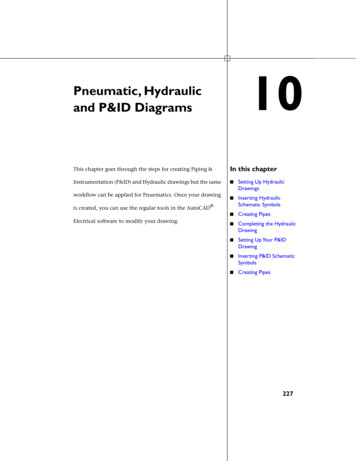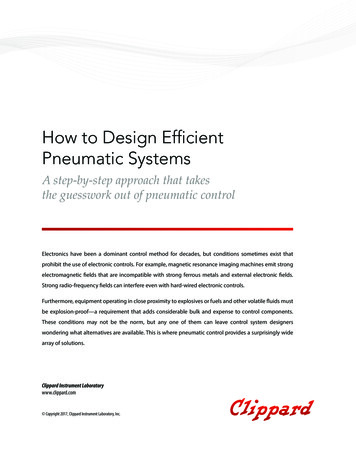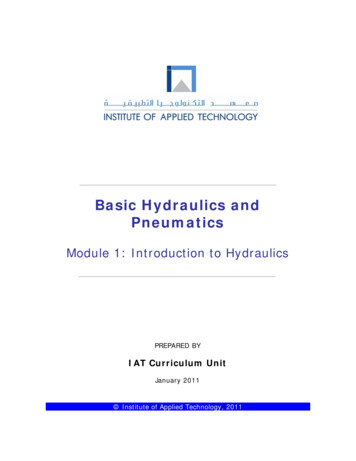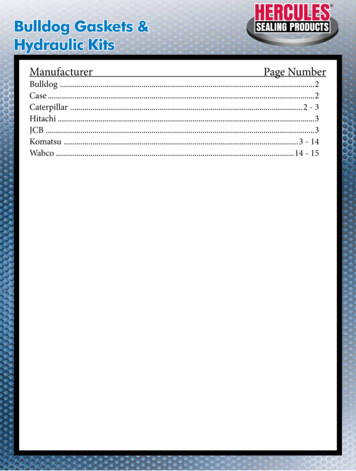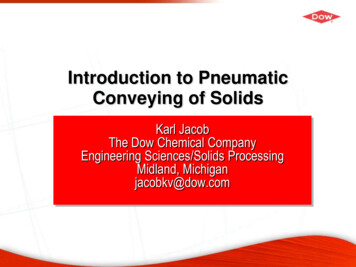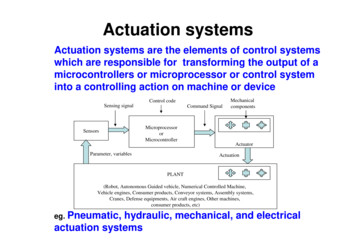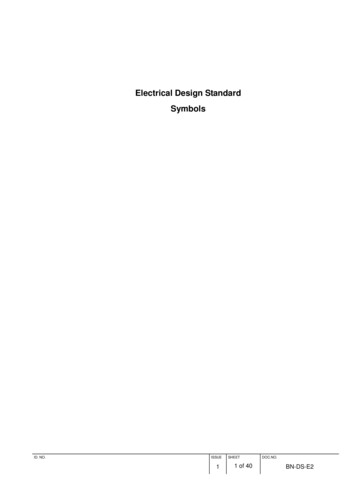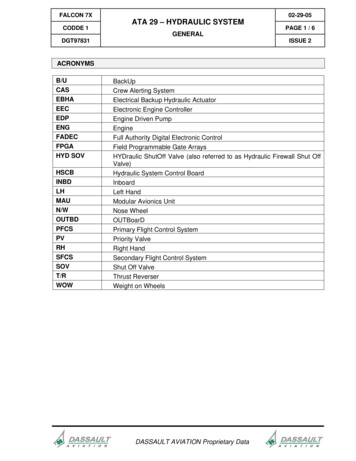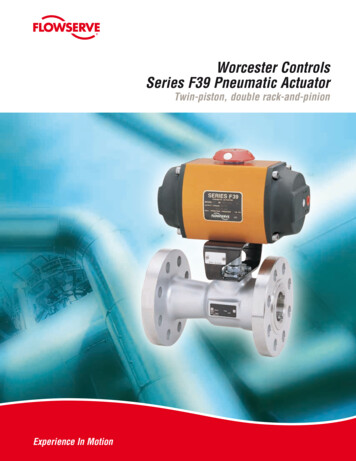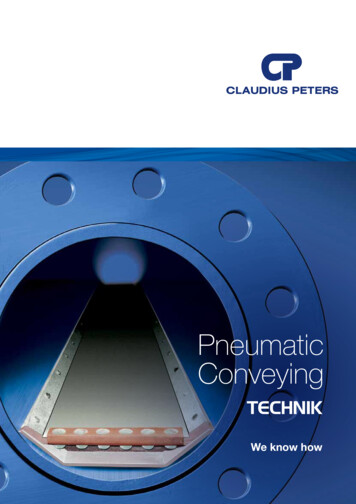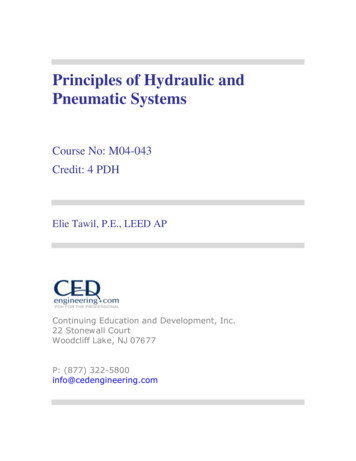
Transcription
Principles of Hydraulic andPneumatic SystemsCourse No: M04-043Credit: 4 PDHElie Tawil, P.E., LEED APContinuing Education and Development, Inc.22 Stonewall CourtWoodcliff Lake, NJ 07677P: (877) 322-5800info@cedengineering.com
Chapter 9Hydraulic and Pneumatic SystemsTopic1.0.0Hydraulic Systems2.0.0Pneumatic SystemsOverviewIn automotive and construction equipment, the terms hydraulic and pneumaticdescribe a method of transmitting power from one place to another through the use of aliquid or a gas. Certain physical laws or principles apply to all liquids and gases.This chapter covers the basic principles associated with hydraulics and pneumatics,followed by coverage of various system components. The purpose of this information isto give you an analytical understanding of the interrelationships of principles and thecomponents of hydraulic and pneumatic operating systems.ObjectivesWhen you have completed this chapter, you will be able to do the following:1. Understand the operating principles of hydraulic systems.2. Identify operational characteristics, component functions, and maintenanceprocedures of a hydraulic system.3. Understand the operating principles of a pneumatic system.4. Identify operational characteristics and service procedures applicable to heavyduty compressors.NAVEDTRA 14264A9-1
PrerequisitesThis course map shows all of the chapters in Construction Mechanic Basic. Thesuggested training order begins at the bottom and proceeds up. Skill levels increase asyou advance on the course map.Automotive Chassis and BodyCBrakesMConstruction Equipment Power TrainsDrive Lines, Differentials, Drive Axles,and Power Train AccessoriesAutomotive Clutches, Transmissions,and TransaxlesHydraulic and Pneumatic c Automotive ElectricitySCooling and Lubrication SystemsIDiesel Fuel SystemsCGasoline Fuel SystemsConstruction of an Internal CombustionEnginePrinciples of an Internal CombustionEngineTechnical AdministrationFeatures of this ManualThis manual has several features which make it easy to use online. Figure and table numbers in the text are italicized. The figure or table is eithernext to or below the text that refers to it. The first time a glossary term appears in the text, it is bold and italicized.When your cursor crosses over that word or phrase, a popup box displayswith the appropriate definition. Audio and video clips are included in the text, with italicized instructions tellingyou where to click to activate it. Review questions that apply to a section are listed under the Test YourKnowledge banner at the end of the section. Select the answer you choose. Ifthe answer is correct, you will be taken to the next section heading. If theNAVEDTRA 14264A9-2
answer is incorrect, you will be taken to the area in the chapter where theinformation is for review. When you have completed your review, selectanywhere in that area to return to the review question. Try to answer thequestion again. Review questions are included at the end of this chapter. Select the answeryou choose. If the answer is correct, you will be taken to the next question. Ifthe answer is incorrect, you will be taken to the area in the chapter where theinformation is for review. When you have completed your review, selectanywhere in that area to return to the review question. Try to answer thequestion again.NAVEDTRA 14264A9-3
1.0.0 HYDRAULIC SYSTEMSThe extensive use of hydraulics to transmit power is due to the fact that a properlyconstructed hydraulic system possesses a number of favorable characteristics: A hydraulic system eliminates the need for complicated systems using gears,cams, and levers. Motion can be transmitted without the slack inherent in the use of solid machineparts. The fluids used are not subject to breakage as are mechanical parts. Hydraulic system mechanisms are not subjected to great wear.If the system is well adapted to the work it is required to perform and is not misused, itcan provide smooth, flexible, uniform action free of vibration and unaffected by variationof load. Hydraulic systems can provide widely variable motions in both rotary andstraight-line transmission of power. The need for control by hand can be minimized. Inaddition, they are economical to operate.1.1.0 Basic Principles of HydraulicsThe basic principles of hydraulics are few and simple: Liquids have no shape of their own. Liquids will NOT compress. Liquids transmit applied pressure in all directions. Liquids provide great increase in work force.1.1.1 Pascal's LawThe foundation of modern hydraulics wasestablished when Blaise Pascal, a Frenchscientist, discovered the fundamental law forthe science of hydraulics.Pascal's law states that pressure applied toaconfinedliquidistransmittedundiminished in all directions and acts withequal force on all equal areas, at rightangles to those areas.According to Pascal's law, any force appliedto a confined fluid is transmitted in alldirections throughout the fluid regardless ofthe shape of the container. Consider theeffect of this in the systems shown in Figure9-1. If there is resistance on the outputpiston (View A, piston 2) and the input pistonis pushed downward, a pressure is createdthrough the fluid which acts equally at rightangles to surfaces in all parts of thecontainer.NAVEDTRA 14264AFigure 9-1 - Force transmittedfrom piston to piston.9-4
Pascal's law is independent of the shape of the container; it is not necessary that thetubing connecting the two pistons be the full area of the pistons. A connection of anysize, shape, or length will do so long as an unobstructed passage is provided.Therefore, the system shown in View B (a relatively small, bent pipe connects the twocylinders) will act the same as that shown in View A.1.1.1.1 PressurePressure (P) is the amount of push or pull (force) applied to each unit area of thesurface and is expressed in pounds per square inch (psi) or grams per squarecentimeter (gm/cm2). Pressure may be exerted in one direction, in several directions, orin all directions.1.1.2 ForceForce (F) means a total push or pull. It is push or pull exerted against the total area of aparticular surface and is expressed in pounds or grams.1.1.3 AreaArea (A) represents the surface area acted upon by the hydraulic force.1.1.4 Computing Force, Pressure, and AreaThe formula used to compute force, pressure, and area in a hydraulic system can bedescribed by force equals pressure times area and is written as: F PxA.Pressure equals force divided by area. By rearranging the above formula, this statementmay be condensed into the following: P F divided by A or P F/A.Since the area equals force divided by pressure, the formula for area is written asfollows: A F/P.If the force is 100 pounds and the area of the input piston is 10 square inches, thenpressure in the fluid is 10 psi (100 10). It must be emphasized that this fluid pressurecannot be created without resistance to flow, which, in this case, is provided by the 100pound force acting against the top of the output piston 2. This pressure acts on piston 2,so for each square inch of its area, it is pushed upward with the force of 10 pounds. Inthis case, a fluid column of a uniform cross section is used so the area of output piston2 is the same as input piston 1, or 10 square inches; therefore, the upward force onoutput piston 2 is 100 pounds-the same as was applied to input piston 1. All that wasaccomplished in this system was to transmit the 100-pound force around a bend;however, this principle underlies practically all mechanical applications of fluid power.1.1.5 Incompressibility and Expansion of LiquidsFor all practical purposes, fluids are incompressible. Under extremely high pressures,the volume of a fluid can be decreased somewhat, though the decrease is so slight thatit is considered to be negligible except by design engineers.Liquids expand and contract because of temperature changes. When liquid in a closedcontainer is subjected to high temperatures, it expands, and this exerts pressure on thewalls of the container; therefore, it is necessary that pressure-relief mechanisms andexpansion chambers be incorporated into hydraulic systems. Without theseprecautionary measures, the expanding fluid could exert enough pressure to rupturethe system.NAVEDTRA 14264A9-5
1.1.6 Transmission of Forces through LiquidsWhen the end of a solid bar is struck, themain force of the blow is carried straightthrough the bar to the other end (Figure 9-2,View A). This happens because the bar isrigid. The direction of the blow almostentirely determines the direction of thetransmitted force. The more rigid the bar, theless force is lost inside the bar or transmittedoutward at right angles to the direction of theblow.When a force is applied to the end of acolumn of confined liquid (Figure 9-2, ViewB), it is transmitted straight through the otherend and is also undiminished in everydirection throughout the column-forward,backward, and sideways-so that thecontaining vessel is literally filled withpressure.Figure 9-2 - Transmission offorce.Another example of this is a fire hose. Theflat hose takes on a circular cross section when it is filled with water under pressure.The outward push of the water is equal in every direction.1.1.7 Multiplication of ForcesSome hydraulic systems are used to multiplyforce. In Figure 9-3, notice that piston 1 issmaller than piston 2. Assume that the areaof the input piston 1 is 2 square inches. Witha resistant force on piston 2, a downwardforce of 20 pounds acting on piston 1creates 10 psi (20 2) in the fluid. Althoughthis force is much smaller than the appliedforces in Figure 9-1, the pressure is thesame because the force is concentrated ona relatively small area.This pressure of 10 psi acts on all parts ofthe fluid container, including the bottom ofoutput piston 2; therefore, the upward forceon output piston 2 is 10 pounds for each ofits 20 square inches of area, or 200 poundsFigure 9-3 - Multiplication of(10 x 20). In this case, the original force hasforce in a hydraulic system.been multiplied tenfold while using the samepressure in the fluid as before. In any system with these dimensions, the ratio of outputforce to input force is always 10 to 1 regardless of the applied force; for example, if theapplied force of input piston 1 is 50 pounds, the pressure in the system is increased to25 psi. This will support a resistant force of 500 pounds on output piston 2.The system works the same in reverse. Consider piston 2 as the input and piston 1 asthe output; then the output force will always be one tenth of the input force.NAVEDTRA 14264A9-6
Therefore, the first basic rule for two pistons used in a fluid power system is the forceacting on each is directly proportional to its area, and the magnitude of each force is theproduct of the pressure and its area.1.2.0 Types of Hydraulic FluidsThere have been many liquids tested for use in hydraulic systems. Currently liquidsbeing tested include mineral oil, water, phosphate ester, water based ethylene glycolcompounds, and silicone fluids. The three most common types of hydraulic fluids arepetroleum-based, synthetic fire-resistant, and water based fire-resistant.1.2.1 Petroleum-Based FluidsThe most common hydraulic fluids used in hydraulic systems are the petroleum-basedoils. These fluids contain additives to protect the fluid from oxidation, to protect themetals from corrosion, to reduce the tendency of the fluid to foam, and to improve theviscosity.1.2.2 Synthetic Fire-Resistant FluidsPetroleum-based oils contain most of the desired traits of a hydraulic fluid. However,they are flammable under normal conditions and can become explosive when subjectedto high pressures and a source of flame or high temperatures. Nonflammable syntheticliquids have been developed for use in hydraulic systems where fire hazards exist.These synthetic fire-resistant fluids are phosphate ester fire-resistant fluid, siliconesynthetic fire-resistant fluid, and the lightweight synthetic fire-resistant fluid.1.3.0 Hydraulic System ComponentsAn arrangement of interconnected components is required to transmit and control powerthrough pressurized fluid. Such an arrangement is commonly referred to as a system.The number and arrangement of the components vary from system to system,depending on application. In many applications, one main system supplies power toseveral subsystems, which are commonly referred to as circuits. The complete systemmay be a small compact unit; more often, however, the components are located atwidely separated points for convenient control.The basic components of a fluid power system are essentially the same, regardless ofwhether the system uses hydraulic or pneumatic medium. The basic components are asfollows: Reservoir Pumps Strainers and filters Valve Types Actuators Motors Accumulators Oil Cooler Cooling Fan Tubing, Piping, and HoseNAVEDTRA 14264A9-7
Connectors and fittings Sealing materials and devicesSeveral applications of fluid power require only a simple system, that is, a system whichuses only a few components in addition to the basic components.1.3.1 ReservoirA properly constructed reservoir is more than just a tank to hold oil until the systemdemands fluid (Figure 9-4). It should also be capable of the following: Dissipating heat from the fluid. Separating air from the oil. Settling out contamination in the oil.Figure 9-4 - Typical hydraulic reservoir.Ideally, the reservoir should be high and narrow rather than shallow and broad. The oillevel should be as high as possible above the opening to the pump suction line. Thiscondition prevents the vacuum at the line opening from causing a vortex or whirlpooleffect. Anytime you see a whirlpool at the suction line opening, the system is taking inair.As a rule of thumb, the reservoir level should be two to three times the pump output perminute. By this rule which works well for stationary machinery, a 20-gallon per minute(gpm) system would require a 40- or 60-gpm reservoir. However, this is not possible formobile equipment. You are more likely to find a 20- or 30-gallon tank to support a 100gpm system. This is possible because mobile systems operate intermittently rather thanall the time. The largest reservoirs are on mobile equipment. These reservoirs may havea 40- or 50- gallon capacity, capable of handling more than 200-gpm output.The reservoir must be sized to ensure there is a reserve of oil with all the cylinders inthe system fully extended. The reserve must be high enough to prevent a whirlpool atthe suction line opening. Also, there must be enough space to hold all the oil when thecylinders retract with some space to spare for expansion of hot oil.NAVEDTRA 14264A9-8
An air vent allows the air to be drawn in and pushed out of the reservoir by the everchanging fluid level. An air filter is attached to the air vent to prevent drawingatmospheric dust into the system by the ever changing fluid level. A firmly secured fillingstrainer of fine mesh wire is always placed below the filler cap.The sight gauge is provided so the normal fluid level can always be seen, as it isessential that the fluid in the reservoir be at the correct level. The baffle platesegregates the outlet fluid from the inlet fluid. Although not a total segregation, it doesallow time to dissipate the air bubbles, lessen the fluid turbulence (contaminants settleout of non-turbulent fluid), and cool the return fluid somewhat before it is picked up bythe pump.Reservoirs used on CESE may vary considerably from that shown in Figure 9-4;however, manufacturers retain many of the noted features as possible depending ondesign limits and use.1.3.2 PumpsThe purpose of a hydraulic pump is to supply a flow of fluid to a hydraulic system. Thepump draws in oil and displaces it, converting mechanical force into fluid force. Thepump does not create system pressure, since only a resistance to the flow can createpressure. As the pump provides flow, it transmits a force to the fluid. As the fluid flowencounters resistance, this force is changed into pressure. Resistance to flow is theresult of a resistance or obstruction in the path of flow. This restriction is normally thework accomplished by the hydraulic system, but can also be restrictions of lines, fittings,and valves within the system. Thus the load imposed on the system or action of apressure-regulating device controls the pressure.Pumps are rated according to their volumetric output and displacement. Volumetricoutput is the amount of fluid a pump can deliver to its outlet port in a certain period oftime at a given speed. Volumetric output is usually expressed in gallons per minute(gpm). Since changes in pump speed affect volumetric output, some pumps are ratedby their displacement. Pump displacement is the amount of fluid the pump can deliverper cycle. Since most pumps use a rotary drive, displacement is usually expressed interms of cubic inches per revolution.Many different methods are used to classify pumps. Terms, such as non-positivedisplacement, positive displacement, fixed displacement, variable displacement, fixeddelivery, variable delivery, constant volume, and others are used to describe pumps.The first two of these terms describe the fundamental division of pumps because allpumps are either non-positive displacement or positive displacement. Basically pumpsthat discharge liquid in a continuous flow are referred to as non-positive displacement,and those that discharge volumes separated by a period of no discharge are referred toas positive displacement.Pumps may also be classified according to the specific design used to create the flow offluid. Practically all hydraulic pumps fall within three designs classifications-centrifugal,rotary, and reciprocating. Since the use of centrifugal pumps is limited, we will discussonly rotary and reciprocating.All rotary pumps have rotating parts that trap the fluid at the inlet (suction) port and forceit through the discharge port into the system. Gears (Figure 9-5), screws (Figure 9-6),lobes (Figure 9-7), and vanes (Figure 9-8) are commonly used to move the fluid. Rotarypumps are positive displacement of the fixed displacement type.NAVEDTRA 14264A9-9
Figure 9-5 - Gear-drivenhydraulic pump.Figure 9-7 - Lobe-drivenhydraulic pump.Figure 9-6 - Screw-drivenhydraulic pump.Figure 9-8 - Vane-drivenhydraulic pump.Rotary pumps are designed with very small clearances between rotating parts andstationary parts to minimize slippage from the discharge side back to the suction side.They are designed to operate at relatively moderate speeds. Operating at high speedscauses erosion and excessive wear, which results in increased clearances.There are numerous types of rotary pumps and various methods of classification. Theymay be classified by shaft position-either vertically or horizontally mounted; the type ofdrive-electric motor, gasoline engine, and so forth; their manufacturer's name; orservice application. However, classification of rotary pumps is generally made accordingto the type of rotating element.NAVEDTRA 14264A9-10
Figure 9-9 - Reciprocatingpump.Figure 9-10 - Radial pistonpump.The term reciprocating is defined as back-and-forth motion. In a reciprocating pump, it isthe back-and-forth motion of pistons inside of cylinders that provides the flow of fluid.Reciprocating pumps, like rotary pumps, operate on the positive principle, that is, eachstroke delivers a definite volume of liquid to the system.The most common type of reciprocating pump is the hand pump (Figure 9-9). There aretwo types of manually operated reciprocating pumps-single action and double action.The single-action pump provides flow during every other stroke, while the double-actionprovides flow during each stroke. Single-action pumps are frequently used in hydraulicjacks.Several types of power-operated hydraulic pumps, such as the radial piston (Figure 910) and axial piston (Figure 9-11), are classified as reciprocating pumps. These pumpsare sometimes classified as rotary pumps because a rotary motion is imparted to thepumps by the source of power. However, the actual pumping is performed by sets ofpistons reciprocating inside sets of cylinders.NAVEDTRA 14264A9-11Figure 9-11 - Axial piston pump.
1.3.3 Strainers and FiltersStrainers are constructed of fine mesh wire screens or of screening elements consistingof specially processed wire of varying thickness wrapped around metal frames. They doNOT provide as fine a screening action as filters, but they offer less resistance to flowand are used in pump suction lines where pressure drop must be kept to a minimum. Ifone strainer is not large enough to handle the supply of the pump, two or more strainerscan be used in parallel.The most common device installed in hydraulic systems to prevent foreign particles andcontaminations from remaining in the system are called filters. They may be located inthe reservoir, in the return line, in the pressure line, or in any other location in thesystem where the designer of the system decides they are needed to safeguard thesystem against impurities.Filters are classified as full flow and partial flow. In the full-flow filter, all fluid that entersthe unit passes through the filtering element, while in the partial-flow filter, only a portionof the fluid passes through the element.1.3.4 Valves TypesIt is all but impossible to design a practical fluid power system without some means ofcontrolling the volume and pressure of the fluid and directing the flow of fluid to theoperating units. This is accomplished by incorporating different types of valves. A valveis defined as any device by which the flow of fluid may be started, stopped, or regulatedby a movable part that opens or obstructs passage.Valves must be accurate in the control of fluid flow and pressure and the sequence ofoperation. Leakage between the valve element and the valve seat is reduced to anegligible quantity by precision machined surfaces, resulting in carefully controlledclearances. This is one of the very important reasons for minimizing contamination inthe system. Contamination causes valves to stick, plugs small orifices, and causesabrasions of the valve seating surfaces which will result in leakage between the valveelement and valve seat when the valve is closed. Any of these can result in inefficientoperation or complete stoppage of the equipment.Valves may be controlled manually, electrically, pneumatically, mechanically,hydraulically, or by combinations of two ormore methods. Factors that determine themethod of control include the purpose of thevalve, the design and purpose of the system,the location of the valve within the system,and the availability of the source of power.Valves are classified according to their use:flow control, pressure control, and directionalcontrol. Some of these valves have multiplefunctions that fall into more than oneclassification.1.3.4.1 Pressure Control ValveThe safe and efficient operation of hydraulicsystems, systems components, and relatedequipment requires a means of controllingpressure. There are many types of automaticpressure control valves. Some of themNAVEDTRA 14264AFigure 9-12 - Relief valve.9-12
merely provide an escape for pressure that exceeds a set pressure, some only reducethe pressure to a lower pressure system or subsystem, and some keep the pressure ina system within a required range. The most common pressure control valves are reliefvalves (Figure 9-12), pressure regulators, pressure-reducing valves, andcounterbalance valves.1.3.4.2 Directional Control ValveDirectional control valves are designed todirect the flow of fluid, at the desired time, tothe point in a fluid power system where it willdo work, for example, using a directionalcontrol valve to drive a ram back and forth inits cylinder. Various other terms are used toidentity directional control valves, such asselector valve, transfer valve, and controlvalve.Directional control valves for hydraulic andpneumatic systems are similar in design andoperation. However, there is one majordifference. The return ports of a hydraulicvalve is ported through a return line to thereservoir, while the similar port in apneumatic valve, commonly referred to as anexhaust port, is usually vented to theatmosphere.Figure 9-13 - Poppet controlvalve.Directional control valves may be operated by differences in pressure acting onopposite sides of the valving element, or they may be positioned manually,mechanically, or electrically. Often two or more methods of operating the same valvewill be used in different phases of its action.Directional control valves may be classified in several ways. Some of the different waysare by the type of control, the number of ports in the valve housing, and the specificfunction of the valve. The most common method is by the type of valving element usedin the construction of the valve. The most common types of valving elements used in ahydraulic system are the poppet (Figure 9-13), rotary spool (Figure 9-14), and slidingspool valves (Figure 9-15).Figure 9-14 - Rotary spool control valve.NAVEDTRA 14264A9-13
Figure 9-15 - Sliding spool control valve.1.3.4.3 Volume Control ValveA volume control valve (Figure 9-16) is avalve that opens by lifting a round orrectangular wedge out of the path of the fluid.The movable object that controls the flow canform a wedge shape or it can be parallel.Typically, these valves should never be usedfor regulating flow unless they are specificallydesigned for that purpose. On opening thevalve, the flow path is enlarged in a highlynonlinear manner with respect to percent ofopening. This means that flow rate does notchange evenly with stem travel. Also, apartially open valve disk tends to vibrate fromthe fluid flow. Most of the flow change occursnear shutoff with a relatively high fluidvelocity causing disk and seatwear and eventual leakage if used toFigure 9-16 - Volume controlregulate flow. Typical volume control valvesvalve.are designed to be fully opened or closed.When fully open, the typical valve has no obstruction in the flow path, resulting in verylow friction loss.1.3.5 ActuatorsHydraulic actuators convert the fluid power from the pump into mechanical work. Inmobile hydraulic systems, actuators can be grouped as hydraulic cylinders andhydraulic motors. A hydraulic cylinder is a linear actuator; a hydraulic motor is a rotaryactuator.An actuating cylinder is a device that converts fluid power to linear motion, or straightline force and motion. Since linear motion is a back-and-forth motion along a straightline, this type of actuator is sometimes referred to as reciprocating. The cylinderconsists of a ram or piston operating within a cylindrical bore. Actuating cylinders maybe installed so that the cylinder is anchored to a stationary structure and the ram orpiston is attached to the mechanism to be operated, or the piston or ram may beNAVEDTRA 14264A9-14
anchored to the stationary structure and the cylinder attached to the mechanism to beoperated.1.3.5.1 CylindersThe terms ram and piston are often used interchangeably. However, a ram-type cylinderis usually considered one in which the cross-sectional area of the piston is more thanone half of the cross-sectional area of the movable element. In most actuating cylindersof this type, the rod and the movable element have equal areas. This type of movableelement is frequently referred to as a plunger. The most common ram-type cylinders arethe single- (Figure 9-17) and the double-acting (Figure 9-18).Figure 9-17 - Single-acting piston type cylinder.The ram-type actuator is primarily used to push rather than pull. Some applicationsrequire simply a flat surface on the external part of the ram for pushing or lifting the unitto be operated. Other applications require some mechanical means of attachment, suchas a clevis or eyebolt. The design of ram-type cylinders varies in many other respects tosatisfy the requirements of different applications.Figure 9-18 - Double-acting piston type cylinder.The piston-type cylinder has an actuating cylinder in which the cross-sectional area ofthe piston is less than one half of the cross-sectional area of the movable element. Thistype of cylinder is normally used for applications that require both push and pullfunctions. The piston-type cylinder is the most common type used in fluid powersystems.NAVEDTRA 14264A9-15
The essential parts of a piston-type cylinder are a cylindrical barrel, a piston and rod,end caps, and suitable seals. The end caps are attached to the end of the barrel. Theseend caps usually contain fluid ports. The end cap on the rod end contains a hole for thepiston rod to pass through. Suitable seals are used between the hole and the piston rodto keep fluid from leaking out and to keep dirt and other contaminants from entering thebarrel. The opposite end cap of most cylinders is provided with a fitting for securing theactuating cylinder to some structure. This end cap is referred to as the anchor end cap.The piston rod may extend through either or both ends of the cylinder. The extendedend of the rod is normally threaded so that some type of mechanical connector, such asan eyebolt or clevis, and locknut can be attached. This threaded connection provides foradjustment between the rod and the unit to be actuated. After the correct adjustment ismade, the locknut is tightened against the connector to prevent the connector fromturning. The other end of the connector is attached to, either directly or throughadditional mechanical linkage, the unit to be actuated.1.3.6 MotorsA hydraulic motor is a device that converts fluid power energy to rotary motion andforce. The function of a motor is opposite that of a pump; oil under pressure is forced inand spilled out, converting fluid force into mechanical force. However, the design andoperation of motors are very simila
The foundation of modern hydraulics was established when Blaise Pascal, a French scientist, discovered the fundamental law for the science of hydraulics. Pascal's law states that pressure applied to a confined liquid is transmitted undiminished in all directions and acts with equal
